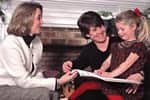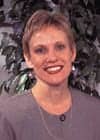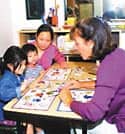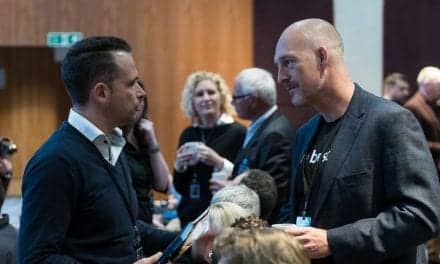
Since 1946, the House Ear Institute (HEI), Los Angeles, has been at the forefront of hearing research and practical innovation, logging a catalog of new technologies and techniques that includes the first marketable cochlear implant device and the first Food and Drug Administration-approved auditory brainstem implant device. These advances are directed toward one goal: the improvement of the quality of life of the hearing impaired. “The whole focus and mission of this institute is eventually to get whatever we’re doing to people who need it,” says James D. Boswell, HEI’s chief executive officer. “We have an uncommonly wonderful opportunity through our sister organization, the House Ear Clinic, which is a world-renowned private practice otology group. Our relationship with the clinic allows us to understand some basic clinical questions, have the physicians that are involved with them actually helping to formulate the queries that are then transformed into some research hypotheses, and help get the application back.”

Boswell cites the cochlear implant as the most significant advance that HEI is responsible for. It is also perhaps one of the most controversial, with advocates for the deaf denouncing it on a regular basis. Boswell says he understands both sides of the debate, but discounts the criticism, defending the technology. “Our philosophy is simple: whatever we can do and whatever the parent can do to help the child, with whatever modality, we should do that, and quite often several modalities work,” he says. “A person who has the cochlear implant also depends on lip-reading, gestures, all the things that all of us do to communicate better. So whatever we can do to improve communications would be our philosophy. We happen to think the cochlear implant does help and, if it can help, why not use it?”
HEI was founded by Howard House, MD, with contributions from two benefactors, patient George Eccles of Salt Lake City and Eccles’ friend Gene Witter of San Francisco, whose daughter was one of House’s patients. The initial grant of $30,000—$15,000 from each man—was used to establish the Los Angeles Foundation of Otology, which later became HEI. Today, the private, nonprofit HEI receives funding from contracts and grants—mainly from the National Institutes of Health (NIH), foundations, individuals, and royalties on five of the products it has developed.

From its original staff of one half-time employee in 1946, the HEI research staff has swelled to over 100, and employs a total of about 180 in 19 separate departments. “It’s not an administratively heavy institution,” says Ali Andalibi, PhD, scientist II and director, new technology and project development.
This absence of administrative bureaucracy has allowed HEI to remain a cutting-edge research facility for more than 50 years.
State-of-the-Art Research
HEI’s laboratory facilities are state of the art and are located within the institute’s five-story headquarters in Los Angeles. “The third floor of the building is pretty much just wet labs; these are the same kind of labs you’d find at institutions like the University of California Los Angeles,” says Andalibi. “That’s where the majority of the activities dealing with cell and molecular biology are located. Many of the investigators are there. On the fourth floor, we have the temporal bone laboratory and some of the investigators conduct work in the fourth floor laboratories as well. In the next few years, we hope to be dedicating more of the space in the institute to laboratories.” And though the laboratories look “run of the mill,” what the researchers are doing is nothing but.
Though HEI’s early research was device-centered, since 1995 research has become more “biological”—looking at causes and cures of hearing loss, which has changed the institute’s position in the continuum of hearing research. “I think that in the early stages, we’ve been very fortunate with the caliber of scientists who are working in our cellular molecular biology labs. All of us in hearing science are early on in the mission of cellular molecular biology in determining causes and cures [of hearing loss], so we’re still building the basic knowledge, but we’re creating the blocks upon which further knowledge can be developed that will have the application,” says Boswell. “It has expanded our ability to make contributions to our mission.”
The research process begins with a hypothesis followed by a formalized program—developed under internal and federal guidelines—to test it. Research can involve clinical trials, which are run in conjunction with the House Ear Clinic. “The wonderful thing about the House Ear Institute/Clinic marriage is that the clinic brings into the forefront of our thoughts, on a daily basis, the fact that this all has to have some sort of application to patients, and at the same time we bring to the attention of the physicians that, without this kind of research, the advances that have led to new therapies and so on would have been impossible,” says Andalibi. “I think there’s a great deal of synergy and mutual respect that exist between us and the physicians.”

It is this relationship with the House Ear Clinic that keeps researchers focused on HEI’s mission to benefit humanity. “I think it’s a very important relationship; the more you have contact with colleagues with different points of view, the more likely you are not to go down the wrong paths,” says Andalibi. “As humans, we all have our biases, but being exposed to different ideas, and in this case just being exposed to the fact that there are patient applications that could be thought of and should be thought of, I think that it’s invaluable, and I think that’s one of the advantages that this environment of clinic and institute offers.”
Not all research is directly applicable to treatments or devices. This research is divided across several areas, including developmental biology and middle ear inflammation. Much of the research can be termed “basic science.” “Our hope in the department of cell and molecular biology is, through a different approach, not necessarily a device-based approach, but just basic science, to also find avenues of therapy for a variety of hearing-related and ear-related problems,” says Andalibi.
Even with all of the cutting edge research that may be years away from bearing fruit, some of the biologic research is already being directed toward applied science. “One of our scientists has been working with naturally occurring antioxidant molecules that seem to have a very profound effect on protecting the hearing end of the cochlea, which is the hair cells, against damage by ototoxic agents,” says Andalibi. “The application of that certainly can be tremendous. People are given ototoxic drugs and all of a sudden they develop a hearing loss, and if you can somehow protect them against that loss, it would be a great benefit to those individuals and society.”

As part of its study of ear diseases, HEI maintains a large tumor bank. “These tumors are not all the same,” says Andalibi. “Some of them are much more aggressive, some are less aggressive, and to look at the difference at a genetic level that leads to this phenotypic variance could in itself open up the doorway to developing new therapies that might help these individuals.”
No matter what the nature of the research is, Andalibi says that it is imperative that HEI’s “gene jocks” stay on mission for a very important reason. “You absolutely must keep the big picture in front of you at all times in order to integrate all the information that comes out,” he says. “Without the reductionistic approach, without some sort of ability to integrate all of this information, it’s just bits and pieces that are interesting, but they may not be as useful unless they’re brought together and integrated into a cohesive system that allows us to see things in a process way.”
Hearing Education
But research is only part of what HEI does. It also is committed to educating professionals and the public.
For professionals, HEI offers an accredited temporal bone dissection course—which includes the largest libraries of research data on temporal bone dissections—that is available to ear, nose, and throat (ENT) specialists from around the world. The institute also offers clinical fellowships, hosts professional conferences, and, through its Visiting Doctor’s Program, hosts ENT specialists from other nations.
But in addition to its clinical programs, HEI runs several outreach programs for nonhearing professionals and the public. Family Camp is a 3-day weekend retreat offered each summer for deaf and hard of hearing children and their families. The goals of the camp are to strengthen the family unit through communication, develop and increase the deaf child’s awareness of peer identity and support, and provide hearing siblings with an opportunity to discuss their feelings and concerns. Boswell says that the camp’s benefit is less for the child than the hearing members of the family unit. “While it is a family camp and while the program revolves around activities for the children, the real focus—and I think the real learning opportunity—is for parents who maybe for the first time have the opportunity to get in groups with other parents and share the common concerns they have of raising children who have a hearing impairment,” he says. “So it’s amazingly beneficial to the children, of course, but to the parents as well.”
The effects of and coping with hearing loss are not HEI’s only concern. Sound Partners is a hearing conservation program that focuses on prevention and is run in conjunction with professionals in the audio, electronic, and recording industries. Boswell says the message of prevention is embedded in HEI’s mission. “Our founder, Howard House, if he didn’t coin the phrase, made sense of it—‘knowledge without sharing is knowledge lost,’” he says. “So that education component is embedded in our mission. Noise-induced hearing loss is still a major contributor to hearing loss in our society. The more we can educate people or give them an opportunity to learn about noise-induced hearing loss, the more inroads we can make in preventing it, and that was the origin of the Sound Partners program.”
For all of HEI’s accomplishments, there are still challenges and new developments facing it.
| 1940s | HEI directs study to establish the OSHA sound exposure guidelines. | 1984 | HEI announces the Food and Drug Administration approval of the first cochlear implant, the 3M/House device for adults. |
| 1960 | HEI develops one of the largest documented temporal bone banks for scientific research. | 1995 | HEI researchers discover how temporal cues (timing) are critical in speech recognition. This leads to improved speech processing strategies for hearing aids and cochlear implants. |
| 1970s | Cochlear implant single-channel sound processor developed. | 2000 | HEI receives Food and Drug Administration approval of the first auditory brainstem implant (ABI) device. |
| 1980s | HEI develops HINT, the first standardized functional hearing test that measures directional hearing in noise. | 2000 | HEI researchers develop ABaer™, an auditory brainstem response-based screening device for detecting hearing loss in newborns and infants. |
Challenges and the Future
Boswell says that there are no endpoints in HEI’s work, quickly listing the work still in front of its researchers. “One of the really huge breakthroughs would be the regeneration or transplantation of inner ear hair cells,” he says. “Along the path, we need to learn a lot more about the genetic cause of hearing loss; understanding the human genome is going to apply, when looking at middle ear disease.”
The biggest challenge facing HEI is its success, which has put institute space at a premium, but Boswell sees this ever-increasing growth as a symptom of good science. “All the most successful science demands growth, because if you’re not increasing the number of people in the field, the work they are doing as they develop new techniques and initiatives or new insights demands that you put additional resources into that, so I see growth as necessary and productive,” he says. “And I think that’s probably true of most science-based, research-based institutes.”
Even with this growth, the institute will probably continue its fundamental mission. “I don’t see that we’ll move out of our basic mission and that is in hearing and related disorders, but you never know where science takes you,” Boswell says.
Chris Wolski is associate editor of Hearing Products Report.





